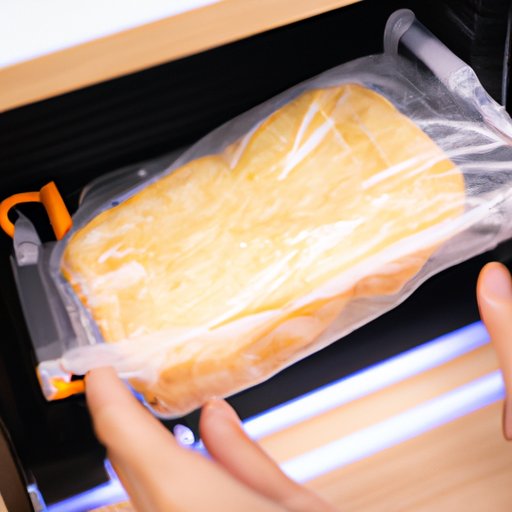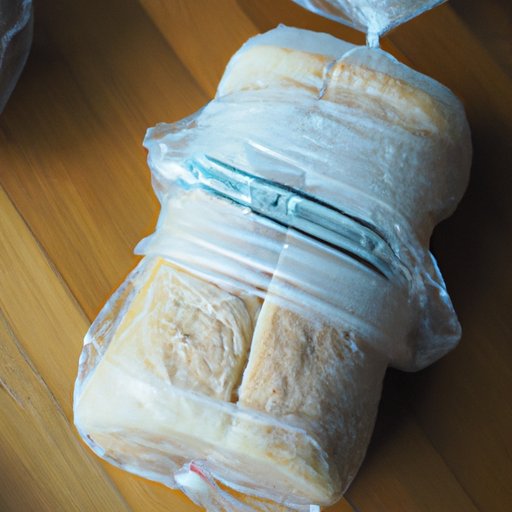
Introduction
Frozen bread can be a common problem in households, especially when you buy bread in bulk or make it yourself. It can be frustrating to find out that your bread is rock solid and inedible when you need it. However, there are several methods to defrost bread that are quick, safe, and effective. In this article, we will explore different methods to help you thaw your bread properly.
The Quick Thaw: How to Defrost Bread in the Microwave
The microwave method is the quickest way to defrost bread. However, it is also the method that can result in slightly dried and tough bread if not done properly. You will need to use your microwave’s defrost function rather than just heating it up to avoid the bread gets cooked from the inside.
Here is how you can defrost bread in the microwave:
- Place the frozen bread in a microwave-safe dish or on a microwave-safe plate, and cover it with a damp paper towel or kitchen towel.
- Set your microwave to its defrost function and select a low power setting.
- Starting with the shortest defrost time setting, defrost the bread in the microwave for 30 seconds.
- Check the bread to see if it has thawed. If not, repeat the process for another 30 seconds until fully thawed.
- If the bread is slightly damp, you can finish the defrosting process by heating it up in the microwave for 10 seconds in low power.
Tips for using the microwave method effectively and safely:
- Do not use high power to defrost bread in the microwave. It will cook the bread rather than thawing it.
- Do not defrost bread in the microwave for too long. It will affect the texture and ruin the bread.
- Place a damp kitchen towel or paper towel over the bread. It will help retain some of the moisture and keep the bread from drying out excessively during the defrost process.
The Gentle Defrost: How to Thaw Bread on the Counter
The counter method is a gentle and easy way to defrost bread. It is an effective method for thick bread and loaves. However, the downside is that it can take a while, and the bread may become hard if not thawed correctly.
Here is how you can defrost bread on the counter:
- Place the frozen bread on a plate or cutting board, and cover it with a clean kitchen towel.
- Leave the bread out on the counter at room temperature to thaw. Thick artisan bread or loaves can take several hours to defrost fully.
- If the bread is in a plastic bag, remove it from the bag before defrosting it.
Tips for using the counter method effectively and safely:
- Do not leave the bread out on the counter for too long. It can start to become dry or develop mold.
- Do not refreeze bread that has been thawed at room temperature. If you don’t use it immediately, store it in the fridge.
- If you want the bread to defrost more quickly or evenly, cut it into slices or small pieces.
The Overnight Method: How to Defrost Bread in the Fridge
The fridge method is a safe and effective way to defrost bread without affecting its quality. It is also the method that requires the most patience, but it’s worth it in the end.
Here is how you can defrost bread in the fridge:
- Place the frozen bread in a sealable plastic bag to prevent moisture loss and place it in the fridge overnight.
- In the morning, take the bread out of the fridge and let it stand at room temperature to warm up for a while before consuming it.
Tips for using the fridge method effectively and safely:
- Plan ahead and defrost bread in the fridge at least a day before you will need it to allow for a complete defrost— this method is not advisable if you need to eat bread urgently.
- Do not store the bread in the fridge after defrosting it for more than two days. If you don’t use it immediately, store it in the freezer.
- If you want the bread to defrost more quickly or evenly, cut it into slices or small pieces.
Don’t Waste a Second: How to Defrost Bread in the Toaster
Defrosting bread in the toaster is the quickest method if you have a toaster with a defrosting option. It is the best option for individuals on the go or those who want to have their frozen bread ready in minutes before heading out of the house.
Here is how to defrost bread in the toaster:
- Insert the frozen bread slices into the toaster’s bread slots.
- Set the toaster on the defrosting option and start the toast cycle.
- After the toaster has stopped, check if the bread has defrosted. Then, add an extra cycle of defrosting to ensure that it is fully defrosted.
Tips for using the toaster method effectively and safely:
- Ensure that you have a toaster with a defrosting option fitted. Otherwise, you might ruin your bread and your toaster too.
- Keep an eye on the bread slices in case they burn due to overexposure to toaster heat.
- The toaster method is best suited for bread slices rather than a whole loaf or thicker bread slice that may not fit into the toaster.
The Slow Thaw: How to Defrost Bread in the Oven
The oven method is another method to defrost bread slowly, ensuring that the bread comes out with its best quality. It is mostly used in bakeries and restaurants, where they need to defrost loaves of bread. It is not the quickest method; however, it is one of the most effective ways to defrost bread from the inside out.
Here is how you can defrost bread in the oven:
- Preheat your oven to 175 degrees F.
- Place frozen bread in the oven on a baking tray or a suitable oven-safe dish.
- Leave the bread in the oven for 15-20 minutes or until it’s fully defrosted.
- Check the bread several times during the defrosting process to ensure it does not burn.
Tips for using the oven method effectively and safely:
- The oven method is best suited for thick loaves of bread and rolls rather than sliced bread.
- Do not use high temperatures; it will cook the bread rather than thawing it.
- Make sure you preheat the oven to the suggested temperature before you place your bread in it.
From Freezer to Table: How to Defrost Bread in the Air Fryer
The air fryer method is the new defrosting kid on the block. It is not as common as other methods; however, it is a perfect method when you need to defrost individual slices of bread quickly. Air fryers have become popular because they use hot air, and you don’t need any oil to make your food crispy.
Here is how you can defrost bread in the air fryer:
- Preheat your air fryer to 400 degrees F.
- Place the frozen bread slices in the air fryer basket.
- Set the air fryer to 3 minutes and turn the bread slices around at the halfway point.
- The bread slices should be completely thawed after three minutes.
Tips for using the air fryer method effectively and safely:
- Use the air fryer method for individual slices of bread rather than whole loaves or thicker bread slices.
- Avoid using this method if you don’t have an air fryer.
- Always pay attention to your air fryer’s instructions when defrosting food items to avoid damage to the air fryer.

DIY Defrost Bag: How to Defrost Bread in a Homemade Thawing Bag
If you don’t have a microwave, toaster, oven, or air fryer, or if you don’t want to defrost bread on the counter or in the fridge, a DIY thawing bag is an affordable and straightforward method to try at home.
Here is how you can make a DIY defrost bag:
- Take a sealable plastic bag and fill it with warm water.
- Drain the water from the bag and dry the bag with a clean towel.
- Place the frozen bread into the thawing bag and seal it, making sure no water gets inside the bag.
- Leave the bread to defrost in the bag for 30 minutes or until it’s fully defrosted.
Tips for using the DIY defrost bag method effectively and safely:
- Do not use hot water to fill the thawing bag. It can cause the plastic to melt and contaminate the bread.
- Ensure that the thawing bag is sealed correctly to avoid water getting inside the bag and damaging the bread.
- Do not reuse the bag; dispose of it after use to prevent contamination.
Conclusion
Defrosting bread is no longer a challenge. With these methods, your frozen bread will be ready to consume in no time. It is essential to choose the right method to defrost your bread, depending on how much time you have and the equipment available. Remember always to follow the safety rules and tips provided in this article to avoid food poisoning or ruining your bread.





